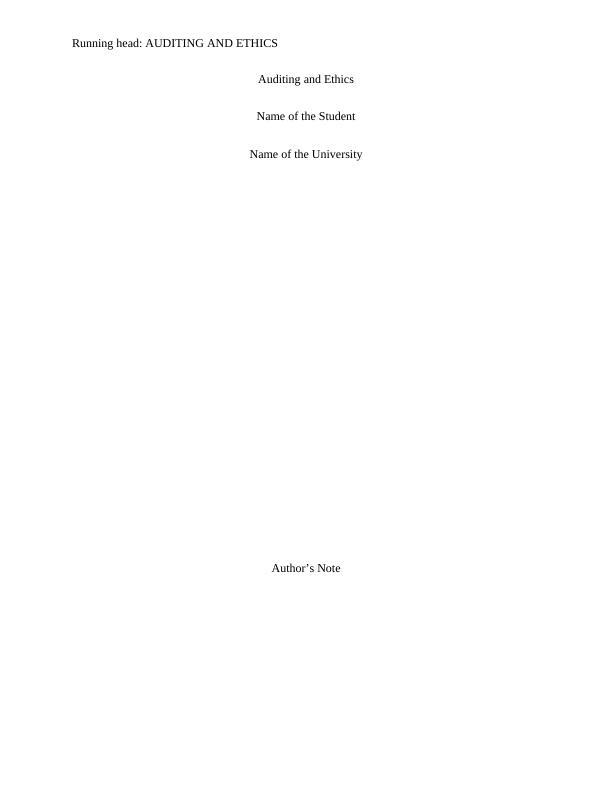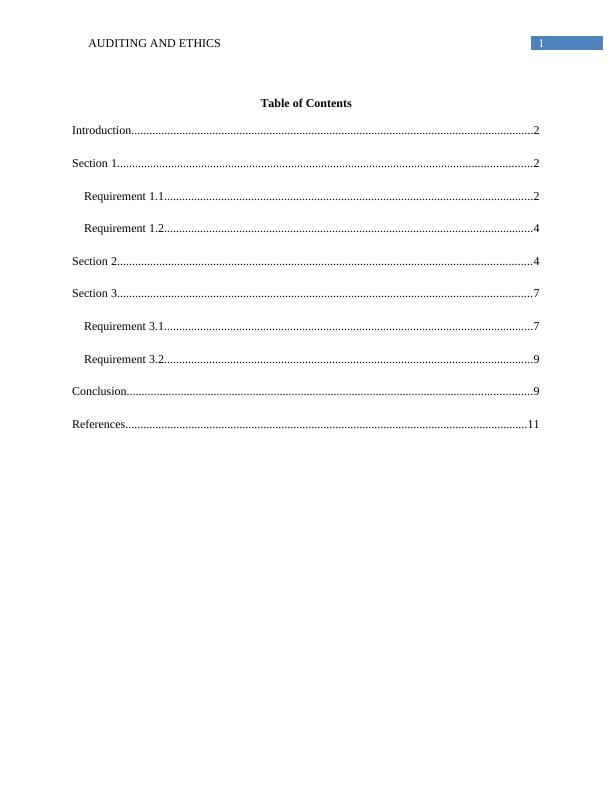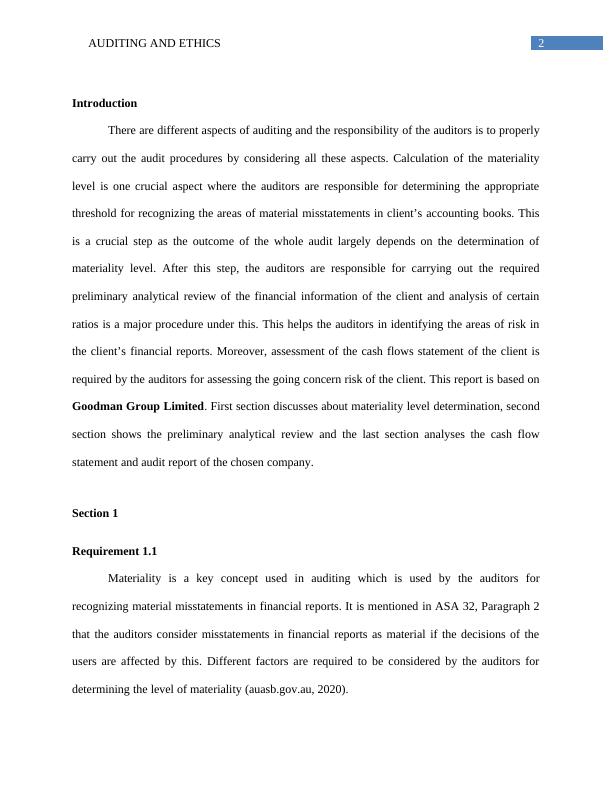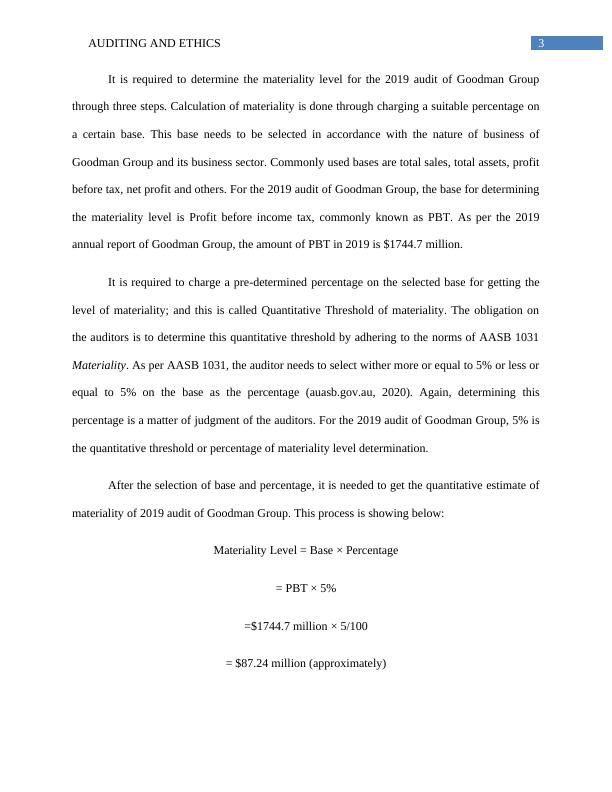THE AUDITING AND ETHICS
Added on 2022-08-29
14 Pages2834 Words19 Views
Running head: AUDITING AND ETHICS
Auditing and Ethics
Name of the Student
Name of the University
Author’s Note
Auditing and Ethics
Name of the Student
Name of the University
Author’s Note

1AUDITING AND ETHICS
Table of Contents
Introduction......................................................................................................................................2
Section 1..........................................................................................................................................2
Requirement 1.1...........................................................................................................................2
Requirement 1.2...........................................................................................................................4
Section 2..........................................................................................................................................4
Section 3..........................................................................................................................................7
Requirement 3.1...........................................................................................................................7
Requirement 3.2...........................................................................................................................9
Conclusion.......................................................................................................................................9
References......................................................................................................................................11
Table of Contents
Introduction......................................................................................................................................2
Section 1..........................................................................................................................................2
Requirement 1.1...........................................................................................................................2
Requirement 1.2...........................................................................................................................4
Section 2..........................................................................................................................................4
Section 3..........................................................................................................................................7
Requirement 3.1...........................................................................................................................7
Requirement 3.2...........................................................................................................................9
Conclusion.......................................................................................................................................9
References......................................................................................................................................11

2AUDITING AND ETHICS
Introduction
There are different aspects of auditing and the responsibility of the auditors is to properly
carry out the audit procedures by considering all these aspects. Calculation of the materiality
level is one crucial aspect where the auditors are responsible for determining the appropriate
threshold for recognizing the areas of material misstatements in client’s accounting books. This
is a crucial step as the outcome of the whole audit largely depends on the determination of
materiality level. After this step, the auditors are responsible for carrying out the required
preliminary analytical review of the financial information of the client and analysis of certain
ratios is a major procedure under this. This helps the auditors in identifying the areas of risk in
the client’s financial reports. Moreover, assessment of the cash flows statement of the client is
required by the auditors for assessing the going concern risk of the client. This report is based on
Goodman Group Limited. First section discusses about materiality level determination, second
section shows the preliminary analytical review and the last section analyses the cash flow
statement and audit report of the chosen company.
Section 1
Requirement 1.1
Materiality is a key concept used in auditing which is used by the auditors for
recognizing material misstatements in financial reports. It is mentioned in ASA 32, Paragraph 2
that the auditors consider misstatements in financial reports as material if the decisions of the
users are affected by this. Different factors are required to be considered by the auditors for
determining the level of materiality (auasb.gov.au, 2020).
Introduction
There are different aspects of auditing and the responsibility of the auditors is to properly
carry out the audit procedures by considering all these aspects. Calculation of the materiality
level is one crucial aspect where the auditors are responsible for determining the appropriate
threshold for recognizing the areas of material misstatements in client’s accounting books. This
is a crucial step as the outcome of the whole audit largely depends on the determination of
materiality level. After this step, the auditors are responsible for carrying out the required
preliminary analytical review of the financial information of the client and analysis of certain
ratios is a major procedure under this. This helps the auditors in identifying the areas of risk in
the client’s financial reports. Moreover, assessment of the cash flows statement of the client is
required by the auditors for assessing the going concern risk of the client. This report is based on
Goodman Group Limited. First section discusses about materiality level determination, second
section shows the preliminary analytical review and the last section analyses the cash flow
statement and audit report of the chosen company.
Section 1
Requirement 1.1
Materiality is a key concept used in auditing which is used by the auditors for
recognizing material misstatements in financial reports. It is mentioned in ASA 32, Paragraph 2
that the auditors consider misstatements in financial reports as material if the decisions of the
users are affected by this. Different factors are required to be considered by the auditors for
determining the level of materiality (auasb.gov.au, 2020).

3AUDITING AND ETHICS
It is required to determine the materiality level for the 2019 audit of Goodman Group
through three steps. Calculation of materiality is done through charging a suitable percentage on
a certain base. This base needs to be selected in accordance with the nature of business of
Goodman Group and its business sector. Commonly used bases are total sales, total assets, profit
before tax, net profit and others. For the 2019 audit of Goodman Group, the base for determining
the materiality level is Profit before income tax, commonly known as PBT. As per the 2019
annual report of Goodman Group, the amount of PBT in 2019 is $1744.7 million.
It is required to charge a pre-determined percentage on the selected base for getting the
level of materiality; and this is called Quantitative Threshold of materiality. The obligation on
the auditors is to determine this quantitative threshold by adhering to the norms of AASB 1031
Materiality. As per AASB 1031, the auditor needs to select wither more or equal to 5% or less or
equal to 5% on the base as the percentage (auasb.gov.au, 2020). Again, determining this
percentage is a matter of judgment of the auditors. For the 2019 audit of Goodman Group, 5% is
the quantitative threshold or percentage of materiality level determination.
After the selection of base and percentage, it is needed to get the quantitative estimate of
materiality of 2019 audit of Goodman Group. This process is showing below:
Materiality Level = Base × Percentage
= PBT × 5%
=$1744.7 million × 5/100
= $87.24 million (approximately)
It is required to determine the materiality level for the 2019 audit of Goodman Group
through three steps. Calculation of materiality is done through charging a suitable percentage on
a certain base. This base needs to be selected in accordance with the nature of business of
Goodman Group and its business sector. Commonly used bases are total sales, total assets, profit
before tax, net profit and others. For the 2019 audit of Goodman Group, the base for determining
the materiality level is Profit before income tax, commonly known as PBT. As per the 2019
annual report of Goodman Group, the amount of PBT in 2019 is $1744.7 million.
It is required to charge a pre-determined percentage on the selected base for getting the
level of materiality; and this is called Quantitative Threshold of materiality. The obligation on
the auditors is to determine this quantitative threshold by adhering to the norms of AASB 1031
Materiality. As per AASB 1031, the auditor needs to select wither more or equal to 5% or less or
equal to 5% on the base as the percentage (auasb.gov.au, 2020). Again, determining this
percentage is a matter of judgment of the auditors. For the 2019 audit of Goodman Group, 5% is
the quantitative threshold or percentage of materiality level determination.
After the selection of base and percentage, it is needed to get the quantitative estimate of
materiality of 2019 audit of Goodman Group. This process is showing below:
Materiality Level = Base × Percentage
= PBT × 5%
=$1744.7 million × 5/100
= $87.24 million (approximately)

End of preview
Want to access all the pages? Upload your documents or become a member.
Related Documents
Auditing and Ethics | Reportlg...
|12
|2828
|37
Auditing and Ethiclg...
|11
|2932
|84
Auditing and Ethics Assignment Samplelg...
|16
|3106
|44
Auditing and Ethical Practiceslg...
|10
|2096
|54
Auditing and Ethicslg...
|13
|3472
|93
AUDITING AND ETHIC DISCUSSION 2022lg...
|13
|3014
|37
